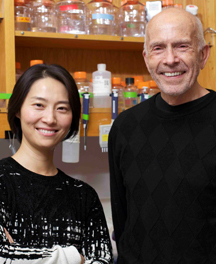Ancient Enzyme Morphed Shape to Carry Out New Functions in Humans
By Madeline McCurry-Schmidt
New research led by scientists at The Scripps Research Institute (TSRI) reveals that a human enzyme has changed little from its days as a bacterial enzyme. In fact, the enzyme appears to be unique in its ability to change its shape—and its job in cells—without overhauling its basic architecture.
“This work illustrates nature’s efficiency—how it can take one thing and convert it to another, with a tweak here and a tweak there,” said Paul Schimmel, professor at TSRI and senior author of the new study.
The findings were published recently in the journal Proceedings of the National Academy of Sciences.
A Unique Enzyme
Schimmel and his colleagues focused on a member of a family of enzymes called aminoacyl tRNA synthetases. These enzymes originated in ancient bacteria, where they decode genetic information to help produce amino acids. Over time, the enzymes have evolved to carry out even more functions in complex lifeforms, such as humans.
“Aminoacyl tRNA synthetases are associated with—and we believe needed for—the building of organismal complexity, such as making tissues and organs in humans,” Schimmel explained.
These new functions are controlled by “decorations,” or additions to the aminoacyl tRNA synthetase architecture, which are generally lacking in bacteria; however, there is one aminoacyl tRNA synthetase, called AlaRS, that lacks any new decorations. AlaRS somehow carries out new roles in humans using a preexisting bacterial domain in its structure.
“AlaRS presented an exception to what we thought was a ‘rule,’ ” said Schimmel.
AlaRS’s Secret
The scientists in the new study took a closer look at AlaRS using two imaging techniques: X-ray crystallography and small-angle X-ray scattering. The images, combined with functional analysis, showed that a domain of AlaRS’s structure, called C-Ala, had been reshaped to take on a new role in humans. The end result is the same as if AlaRS had gained a new decoration.
Schimmel compared it to reshaping an airplane’s wing to serve as the airplane’s tail instead. “Nature has provided ways for reshaping objects, like C-Ala, and when that happens, new functions occur,” he said.
Schimmel said the next step is to figure out the function of human C-Ala. This work may shed light on diseases linked to mutations in aminoacyl tRNA synthetases, such as the neurodegenerative disease Charcot-Marie-Tooth.
In addition to Schimmel, authors of the study, “Two Crystal Structures Reveal Design for Repurposing the C-Ala Domain of Human AlaRS,” are Litao Sun (first author), Youngzee Song, David Blocquel and Xiang-Lei Yang of TSRI.
This work was supported by the National Cancer Institute (grant CA92577), the National Foundation for Cancer Research and the National Institutes of Health (grant R01 NS085092).
Send comments to: press[at]scripps.edu














